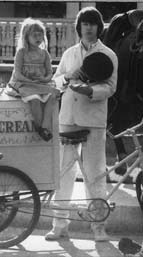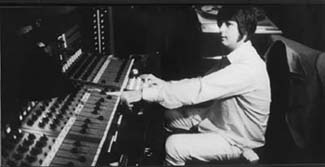|
By the time "Good Vibrations"
had hit No.1 at the end of 1966, Brian was firmly
committed to extending pop's boundaries as far as he could.
Gathering around him a coterie of brilliant, precocious
scene-makers—Van Dyke Parks, Loren Schwartz, Danny
Hutton, David Anderle, writers Jules Siegel and Paul Jay
Robbins—he dug in deep and all but kissed goodbye
to the Beach Boys of old. Most important among these men
was Parks, the diminutive, bespectacled keyboard player
whom he'd first met at Terry Melcher’s house on Cielo
Drive in February 1966.
Van Dyke had first come
to Hollywood as a child actor and was already renowned
as an eccentric on the LA scene. He lived in a tiny room
above a garage on Melrose Avenue, where (in Brian's words)
he would hold court in "funny, poetic, often beguiling
torrents" invariably fuelled by amphetamines. For Brian,
Parks' "intellectual passion and esoteric way with words
seemed to mesh with the way I was feeling," and he invited
him to come up to the house on Laurel Way to write.
 |
"I knew that I could write
lyrics and that he was looking for a lyricist," Parks
tells me. "What I had to offer was the diligence I associated
with the crafting of lyrics from what I thought were the
halcyon days of the pop song in America... the days of
Cole Porter and great musical theatre. I was interested
in the thoughtfulness of cadence that had preceded rock
'n' roll. Even if I couldn't pose as a rustic, I thought
I might be able to walk away from this thing with the
pride in accomplishment that I associated with Hoagy Carmichael."
Listening to a Van Dyke
Parks monologue, delivered in a wonderfully camp, Southern-inflected
voice, is a joyous experience. When you do get in the
odd question, the reply lasts half an hour and takes in
all manner of asides and digressions. Parks is a man who
seems to have grasped the essence of Los Angeles as a
music town without ever having been tainted by what he
calls its "innate criminality." It's not hard to understand
just how refreshing he must have been to Brian Wilson
after five years of Mike Love.
"Brian was in the middle
of 'Sloop John B' when I first went up to see him," Parks
continues. "He told me about his hearing loss, and said
he was very interested in stereo even though he could
only hear monophonically. I'd go to the 'Good Vibrations'
sessions and play piano or marimba. I enjoyed his daring
in the studio, his fantastic enthusiasm. Nobody was doing
anything like that anywhere. You can imagine how Brian's
recording procedure threatened the record company bureaucrats,
but through the force of his personality he changed the
equation and got the financiers to accommodate his experimentation."
 |
After the completion of
"Good Vibrations," Wilson and Parks began working in earnest
on a number of new songs intended to form part of a bold
new work called Dumb Angel. "I imagined to myself
a whole new form of music—religious, white, spiritual
music," Brian later recalled, and he told Van Dyke the
album would be 'a teenage symphony to God.'" Aided by
copious amounts of speed and black Afghani hash, the two
men worked through the late summer and fall, writing the
epic "Heroes and Villains" and some of the songs which
subsequently wound up on Smiley Smile and 20/20.
Dumb Angel, of course,
became known as Smile, the title given to the most
famous unreleased album of all time and the great rallying-call
for Brian Wilson fanatics the world over. Although we'll
almost certainly never have the Smile that Wilson
intended to release, the songs which he and Van Dyke Parks
wrote through those months into early 1967 comprise of
the most intoxicatingly beautiful, dementedly ambitious
pop ever committed to tape. This was Pet Sounds
on twenty tabs of acid:
featuring unabashedly literary lyrics about the Old West,
or even stranger ones about vegetables and balding women;
it was Brian's very own Fantasia. "Smile was
going to be a monument," said David Anderle. "That's the
way we talked about it, as a monument."
 |
Unfortunately, by the time
Brian was recording these songs his mind had really been
fried by acid. The domestic situation on Laurel Way was
strange enough, what with the business meetings being
held in the swimming pool and the construction of a sandpit
around Brian's piano, but the Smile recording sessions
were thoroughly unhinged. If Van Dyke Parks was right
that after Pet Sounds "the studio experience itself
became more emphatically, demonstrably, and persuasively
dominant over the way a performance took place in a proscenium,"
that hardly accounted for Brian freaking out and aborting
the orchestral "Fire" suite because he thought he was
causing real fires in Los Angeles. Even more worrying
was the psychotic episode that occurred when he went to
see John Frankenheimer's film Seconds and came
out convinced the director had conspired with none other
than Phil Spector to "mess with my head."
Perhaps the shadow of Spector's
failure with "River Deep" hung over Brian in the first
half of 1967, because he seemed to be doing everything
he could to sabotage Smile. Even Van Dyke Parks
found it hard to handle the excess and insanity around
Brian, though he remained sufficiently awestruck by the
man's genius to continue work on such masterpieces as
"Surf's Up." For David Anderle, who'd been appointed head
of Brian's new Brother label, it was inevitable that two
such remarkable men would at some point be unable to work
together. "Van Dyke blew Brian's mind, and I hadn't seen
anyone else do that," Anderle told Paul Williams, but
he felt that at most they had "a great moment of creativity"
and thought that "Surf's Up" was the only "perfect blending"
they achieved. "Their parting was kind of tragic, in the
fact that they were two people who absolutely did not
want to separate, but who had to separate." Ironically,
despite its title, "Surf's Up" did not concern the waves
which had inspire Brian's early songs, though its "surf"
did imply the mystical sense of a wave as "the eternal
now." Performed by Brian alone at the piano during a Leonard
Bernstein CBS-TV special on pop music, it was later revisited
by the Beach Boys sans Brian—and more than
creditably—on the title track of their 1971 album.
It didn't help matters
that the other Beach Boys were openly hostile to Parks,
with Mike Love dismissing his lyrics as mere "acid alliteration"
and the rest of them quick to express their suspicion
of the whole clique around Brian. David Anderle urged
Brian to make Smile a solo project, but the eldest
Wilson brother lacked the strength to stand up to the
band. "Brian would go through tremendous paranoia before
he'd get into the studio, knowing he was going to have
to face an argument," Anderle remembered. For his part,
Van Dyke claims he "walked away from the situation as
soon as I realized it was causing friction between Brian
and the group." His final Smile session took place
on 14 April.
Parks believes that the
"huge mutual lawsuit" which destroyed the dream of Smile
could only be comprehended by someone who'd read Dickens'
Bleak House. "It can consume a life and still the
most expressive creative spirit," he says. "So that's
what happened to our effort, and that's why I am now back
at the age of 50 trying to bring meaning to this tremendous
and unlimited respect I have for Brian Wilson." By way
of concluding my interview with him, he proceeds to play
me two songs ("Hold Back Time" and "Orange Crate Art")
from a new solo-album-in-the-making, both of them featuring
Wilson on vocals. They're not quite "Surf's Up" or "Cabinessence,"
but the multi-tracked Brian Wilson harmonies on "Orange
Crate Art" are about as close to the glories of Smile
as either of the two men has come since they last worked
together.
 |
When Brian met Paul McCartney
at Derek Taylor's Laurel Canyon house in April 1967, it
was already clear that Smile might never see the
light of day. Instead, Brian cobbled together the Smiley
Smile album from the debris, including new versions
of such Smile songs as "Vegetables," "Wonderful,"
and "Wind Chimes." After Pet Soundsミand
despite the inclusion of "Good Vibrations" and "Heroes
and Villains"—the album sounded extremely spare and
pared-down, with low-key instrumentation and only the
odd woodblock where there was any percussion at all. It
also sounded very stoned and pretty silly, easy to dismiss.
But there were beautiful moments and motifs embedded in
the curious half-sketches for songs: exquisite, evanescent
melodies, honeyed close-harmony singing as lovely as anything
the Beach Boys ever did. And there was something to be
said for the sheer acid-casualty spookiness of 'Vegetables'
and 'Wind Chimes'—the sound of the once squeaky-clean
surfer buddies tripping out of the Southern California
dream state—especially when one considers Dennis
Wilson's association with Charles Manson.
Most of Smiley Smile
was recorded in Brian's new Bel Air mansion on Bellagio
Road, acquired after Capitol's official cancellation of
Smile at the end of April 1967. This was where
the genius would enact, as Phil Spector was doing, his
very own version of Norma Desmond's self-incarceration
in Sunset Boulevard—especially
after the epic "Heroes and Villains" stalled at No. 12
and Smiley Smile failed even to penetrate the Top
40. The release of Sgt Pepper, meanwhile, was for
Brian the equivalent of Amundsen beating Scott to the
South Pole. And when the Beach Boys pulled out of the
Monterey Pop Festival that summer, afraid to line up alongside
the Byrds and Buffalo Springfield, their day was all but
done.
Excerpted
from Barney Hoskyns' Waiting For the Sun: Strange Days,
Weird Scenes and the Sound of Los Angeles (St. Martin's
Press, 1996). Hoskyns is the editor of Rock's Backpages
[www.rocksbackpages.com],
the Online Library of Rock & Roll.
|